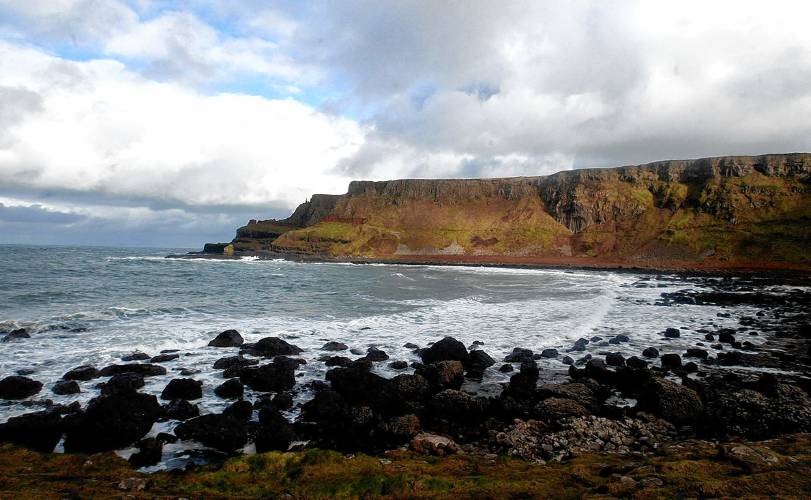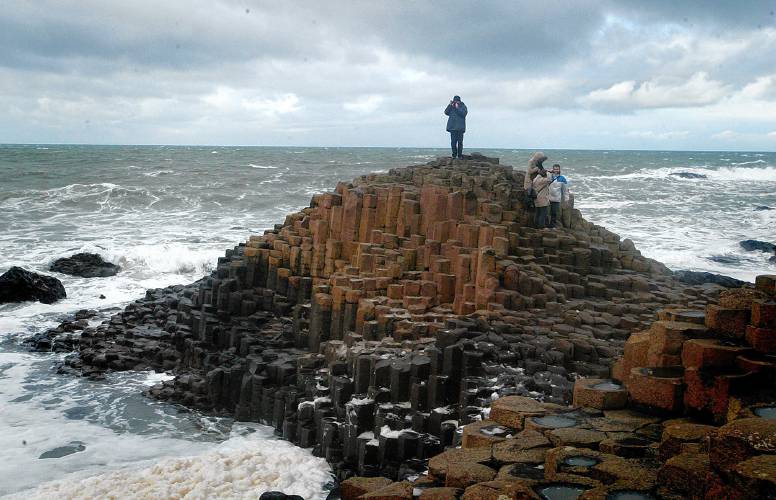Opinion: Learning from landscapes
| Published: 04-27-2024 8:00 AM |
Parker Potter is a former archaeologist and historian, and a retired lawyer. He is currently a semi-professional dog walker who lives and works in Contoocook.
Not long after my family and I returned from Ireland last summer, I started putting up Facebook posts with photographs from our trip. Kindly Mr. Algorithm responded by sending me dozens of pictures of Irish landscapes. I was thrilled, and paid it forward by hitting the “share” button. A lot.
The next thing I knew, I was being pulled into a feedback loop I like to call the Irish landscape spin cycle. After taking a couple of spins through the cycle, I started thinking about just how those Irish landscapes I love so much came to be.
I began with Ireland’s raw natural beauty, on full display at places such as the Cliffs of Moher and the Giant’s Causeway and in areas such as the Burren, south of Galway, and Connemara, north of Galway. The Cliffs of Moher, the Giant’s Causeway, and much of the Wild Atlantic Way are breathtaking reminders that Ireland is basically a great big rock surrounded by water.
But boy oh boy, is that rock green. As we rode around Ireland I saw every shade of green I had ever seen before plus several others I had never even imagined. A favorable location has begotten weather conditions that have made Ireland the greenest rock you will ever see.
As a result, in places such as the Dingle Peninsula, we saw steep rocky slopes rising up from the choppy sea, slopes covered in green, green covered with sheep, sheep tended by hard-working dogs and people wearing woolen sweaters.
I’m pretty sure that nature didn’t make Ireland look the way it does just to give me something beautiful to behold, but still, the natural beauty of Ireland taught me a lesson: to recognize and acknowledge the power of nature and the majesty of the natural world.
Mother Nature is not the only one who has had a hand in creating Irish landscapes. Early in our bus tour, our guide made a point of telling us that there are no nuclear power plants in Ireland, and I tucked that fact away in the back of my mind.
Article continues after...
Yesterday's Most Read Articles
 New Hampshire legalizes public alcohol consumption in designated ‘social districts’
New Hampshire legalizes public alcohol consumption in designated ‘social districts’
 New Hampshire providers brace for Medicaid changes that reach beyond healthcare
New Hampshire providers brace for Medicaid changes that reach beyond healthcare
 Warner town administrator granted restraining order against selectman
Warner town administrator granted restraining order against selectman
 Hotel makeover underway in downtown Concord
Hotel makeover underway in downtown Concord
 Opinion: Dear Gov. Ayotte, let’s talk about the books
Opinion: Dear Gov. Ayotte, let’s talk about the books
 State rules Epsom must pay open-enrollment tuition to other school districts, despite its refraining from the program
State rules Epsom must pay open-enrollment tuition to other school districts, despite its refraining from the program
As we drove through the countryside, it began to dawn on me that Irish farmers seem to live softly on the land. They use the land gently, but they use every inch of it; there are sheep everywhere, many of them grazing on land that, to my untrained eye, hardly looked fit for productive agriculture.
But the farms, which often looked like a giant patchwork quilt, seemed to be beautifully fitted to the landscapes they occupied, and as best I could tell, the lines between the patches in the quilt were stone walls that had been standing in their places, doing their jobs, for hundreds of years for generations of farmers.
The lesson of Ireland’s agricultural landscapes is that making a living from the land can be done by collaborating with the land rather than trying to dominate it.
In addition to being moved by Ireland’s natural splendor and the gentle beauty of Irish agricultural landscapes, I was also very much taken with the ubiquitous ruins. For centuries, people in Ireland have used the gray stone beneath their feet to construct all kinds of buildings, and as we drove across the country, we saw stone ruins of every imaginable form. Roofs and windows gone, walls still standing firm against the wind and rain. We saw ruins of castles, tower houses, churches, monastic villages, and cottages, dozens of tiny stone cottages.
Whenever we passed by an abandoned stone cottage, I imagined an Irish farm family snuggled warmly inside eating dinner around a stove with a glowing lump of turf after a long day’s work. A picture of rural domestic bliss.
That, of course, is the same mistake I make when I visit places like Colonial Williamsburg and see beautifully restored eighteenth-century houses. I project myself back into those houses living a happy life, but I unconsciously add in all sorts of modern conveniences such as electricity and central air conditioning and unconsciously edit out all sorts of eighteenth-century realities such as the stench of human and animal waste that must have permeated Williamsburg in the summer months.
Then there is the question of how so many little Irish cottages came to be abandoned. I don’t know for certain, but I have to think that many of those cottages lost their inhabitants as a result of the death and dislocation that accompanied the nineteenth-century potato blight and famine. So, my charming picturesque landscape features are actually the product of a human tragedy, one that may have claimed distantly related Potters who didn’t immigrate to the United States as my ancestors George and Thomas Potter did in 1828.
The lesson of Ireland’s abandoned cottages is to think carefully and deeply about the things I saw, and see, in order to understand them more fully.









 Opinion: Trumpism in a dying democracy
Opinion: Trumpism in a dying democracy Opinion: What Coolidge’s century-old decision can teach us today
Opinion: What Coolidge’s century-old decision can teach us today Opinion: The art of diplomacy
Opinion: The art of diplomacy Opinion: After Roe: Three years of resistance, care and community
Opinion: After Roe: Three years of resistance, care and community
